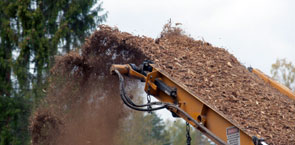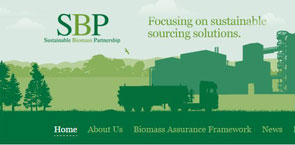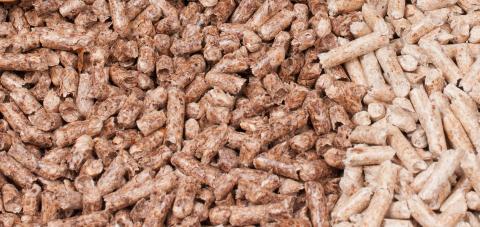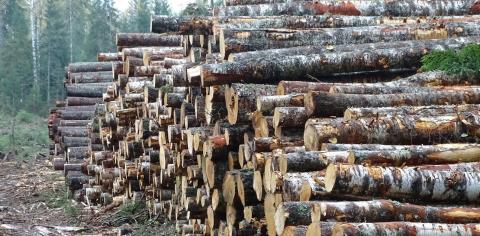Biomass boost: Implications for FSC and PEFC
Green energy is on the rise in the EU, and leading European bioenergy producers will soon be demanding woody biomass from responsible origins. This could add value to FSC and PEFC certified forests and wood pellets.
 Brushwood, sawdust, wood chips, and other woody debris are often sold and used for two types of product: Paper and wood pellets. ‘Wood waste’ can thus provide welcome revenue for the forest owner.
Brushwood, sawdust, wood chips, and other woody debris are often sold and used for two types of product: Paper and wood pellets. ‘Wood waste’ can thus provide welcome revenue for the forest owner.
Today, the paper sector often demands sustainable and certified material, whilst the biomass industry remains a significant sales outlet for non-certified forest residues.
However, this may be about to change. Based on EU policies, demands for certified feedstock are set to grow in the bioenergy sector.
The EU’s 2020 climate and energy goals are pushing EU countries to increase their share of green energy and reduce their emissions. As part of their effort to meet the goals, the EU member states are adopting new requirements that apply to biomass. Biomass is a key renewable energy resource: Together with renewable waste, it accounts for over 65% of the total renewable energy produced in the EU.
Certification of responsible biomass
 This situation has led seven major European bioenergy producers to form the Sustainable Biomass Partnership (SBP).
This situation has led seven major European bioenergy producers to form the Sustainable Biomass Partnership (SBP).
Executive Director of SBP Peter Wilson explains: “The primary goal of the SBP is to develop a mechanism that allows energy generators to demonstrate that they meet these new requirements in a robust and efficient way".
He adds: "Our sector is under great time pressure to fulfil governmental targets and regulations. Unfortunately, there is insufficient uptake of FSC and PEFC forest-level certification in some key wood baskets and these schemes do not meet all the energy sector’s needs such as carriage of greenhouse gas data along the supply chain”.
The SBP has been developing a certification system to demonstrate compliance with the EU and country requirements with the main focus on Belgium, Denmark, the Netherlands and the UK. Under this system, it is not forest managers who are certified but the pellet mills and other biomass producers who are required to conduct a Supply Base Evaluation verifying the sustainable origin of woody biomass. They also need to provide data that can be fed into carbon calculations.
The SBP is fast-tracking the development of the scheme. Mr Wilson: “Governments across Europe are adopting their own timelines. Each has their own carbon calculator tool for which bioenergy producers need to provide data and each has requirements relating to the sustainable origin of woody biomass. In some countries, regulations are kicking in early next year. For example, new rules apply in the UK from April 2015 but the Belgian and Dutch rules are still to be finalised and the Danes are expected to rely on a voluntary agreement with generators. We are working to come up with a solution enabling our sector to deliver all these requirements on time”.
The SBP certification system is currently being field tested. Mr Wilson expects it will be fully functional from early 2015.
How does SBP certification work?
SBP certification applies to biomass producers. Certification requires:
1. Delivery of a range of carbon and energy data related to the pellets. Some of these are related to the forest operations and some to mill operations.
2. A Supply Base Evaluation to ensure that the material fulfils the SBP Sustainable Feedstock Standard. Materials that are 100% FSC or 100% PEFC certified are exempt from evaluation and can be sourced directly as SBP-approved material. Materials with an FSC Controlled Wood or PEFC Controlled Sources claim are also accepted, however only 30% of the raw material used for wood pellets may consist of controlled material.
If the material is not FSC or PEFC certified or carries FSC or PEFC ‘controlled’ claims, it needs to be evaluated according to SBP’s Sustainable Feedstock Standard. The Standard uses a risk-based approach similar to the FSC Controlled Wood Standard, but with many additional requirements.
The pellet mills will be responsible for conducting the evaluation and gathering the carbon data. However, independent SBP-approved certification bodies will check the quality of the mills’ work. Only organisations that already hold FSC or PEFC accreditation are eligible to perform as SBP auditors, subject to special approval by SBP.
Impact on FSC and PEFC
European bioenergy producers are sourcing from many regions. Around the world, forest operations, primary processing industries and pellet mills supplying to the energy sector may soon face the SBP requirements.
How is this going to affect the FSC and PEFC schemes? Mr Wilson underlines that the SBP is not trying to reinvent forest certification.
“Our solution is sort of a halfway house that does not compete with the FSC or PEFC forest-level certifications”, he says. “It builds on existing solutions created by FSC and PEFC wherever possible. The focus is primarily on meeting the regulatory requirements that generators need to fulfil in the short term, but the SBP requirements do go further in terms of sustainability”.
The industry can’t simply source certified biomass to meet the new requirements. "For one thing, FSC and PEFC don’t deliver the full range of generators’ requirements. For example, they don’t deliver carbon related data. And they don’t cover all sources of woody biomass, such as growth along railroads in the rural landscape”, explains NEPCon biomass expert Ondrej Tarabus.
In addition, certified supplies don’t match demands. Danish DONG Energy is one of the organisations behind the SBP. Lead Sustainability Advisor at DONG Energy Peter Kristensen comments: “We prefer FSC certified material, but the amounts available on the market are woefully inadequate”. He points out that FSC has not yet been effective in engaging small forest operations. Millions of smallholders own and manage vast forest resources in some of DONG Energy’s main sourcing areas, including Europe and North America.
Mr Kristensen underlines that the bioenergy sector would prefer the schemes to deliver more of the SBP requirements: “We would welcome carbon data being built into the FSC and PEFC systems”, he says.
According to Mr Kristensen, the SBP initiative is more likely to be a gentle nudge than a big push towards forest certification. “The SBP initiative will reinforce the value of certification, but it isn’t likely to become a large-scale driver of FSC or PEFC forest certification. After all, sales of biomass only provide marginal income for the forest owner”, he says.
Mr Tarabus concurs but stresses that the impact will vary: “In some areas, demands from the bioenergy producers could create a real push for forest certification. This may be the case in the Baltic countries which have large forest resources as well as thriving sawmilling and wood pellet industries. And the SBP could be a major driver of certification of bioenergy plantations”.
Mr Tarabus believes that the SBP can help to address a growing problem of unsustainable harvesting of forest residues. “Sometimes the forest floor is ‘vacuum-cleaned’ - all woody debris is swept away and nothing is left. The SBP standard includes criteria for maintaining productive soils. This may help to ensure the right balance”, he points out.
About the Sustainable Biomass Partnership
The Sustainable Biomass Partnership (SBP) is an initiative led by seven major European utilities that use biomass – mainly wood pellets – in large thermal power plants. These are: DONG Energy, Drax, E.ON, GDF SUEZ, RWE, Vattenfall and HOFOR. SBP aims to support a sustainable solid biomass supply chain that contributes to a low carbon economy.
NEPCon is applying to become an SBP-approved certification body. NEPCon is also assisting the SBP in testing the SBP sustainability standard and in piloting SBP National Risk Assessments.



